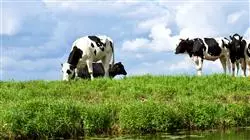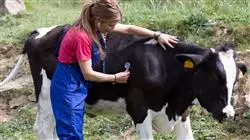University certificate
The world's largest faculty of veterinary medicine”
Introduction to the Program
We offer you the most comprehensive program on the market to bring Extensive Livestock Management to the same level as clinical and sanitary practice, offering your clients the highest quality in both services"

The Postgraduate certificate in Beef and Lidia Cattle in Extensive Farming Systems has a comprehensive program that covers the widest spectrum of species and breeds used in Animal Production in Extensive Systems. Not only is in-depth and specialized attention paid to the most common productions, but also to other much less common but highly relevant productions, which demand a greater degree of specialization from professionals in the area.
Likewise, the degree of knowledge and professional experience of the professors of the Postgraduate Certificate allow them to deal with very specific productions, where it is very difficult to access levels of specialization, except for the small number of people who have had the opportunity to develop their knowledge within the scope of this type of livestock farming.
This program is the most specialized since the development of each subject is structured according to the knowledge and experience of the teaching team, avoiding generalist voluntarism which, although it can provide acceptable global visions, lacks the capacity to study in depth each and every one of the subjects that need to be addressed with the highest quality.
The high levels of knowledge provided by the faculty in the areas of Economics, as well as Genetics and Animal Breeding contribute decisively to consolidate and broaden knowledge in two subjects that are absolutely fundamental for the development of the company.
Immerse yourself in this high-quality education, which will enable you to face the future challenges of Beef and Lidia Cattle in Extensive Farming Systems"
This Postgraduate certificate in Beef and Lidia Cattle in Extensive Farming Systems contains the most complete and up-to-date scientific program on the market. The most important features include:
- The development of case studies presented by experts in the management of veterinary centers
- The graphic, schematic, and practical contents with which they are created, provide scientific and practical information on the disciplines that are essential for professional practice
- New developments in Beef and Lidia Cattle in Extensive Farming Systemss
- Practical exercises where self-assessment can be used to improve learning
- Special emphasis on innovative methodologies in Beef and Lidia Cattle in Extensive Farming Systems
- Theoretical lessons, questions to the expert, debate forums on controversial topics, and individual reflection assignments
- Content that is accessible from any fixed or portable device with an Internet connection
This Postgraduate certificate is the best investment you can make in selecting a refresher program to update your knowledge in Beef and Lidia Cattle in Extensive Farming Systems"
It includes, in its teaching staff, professionals belonging to the field of extensive livestock farming, who bring their work experience to this program, in addition to recognized specialists from prestigious reference societies and universities.
The multimedia content, developed with the latest educational technology, will provide the professional with situated and contextual learning, i.e., a simulated environment that will provide immersive education programmed to learn in real situations.
This program is designed around Problem-Based Learning, whereby the specialist must try to solve the different professional practice situations that arise throughout the program. To do so, the professional will be assisted by an innovative interactive video system created by recognized experts in Extensive Livestock Management.
This program comes with the best educational material, providing you with a contextual approach that will facilitate your learning"

This 100% online Postgraduate certificate will allow you to balance your studies with your professional work while increasing your knowledge in this field"
Why study at TECH?
TECH is the world’s largest online university. With an impressive catalog of more than 14,000 university programs available in 11 languages, it is positioned as a leader in employability, with a 99% job placement rate. In addition, it relies on an enormous faculty of more than 6,000 professors of the highest international renown.

Study at the world's largest online university and guarantee your professional success. The future starts at TECH”
The world’s best online university according to FORBES
The prestigious Forbes magazine, specialized in business and finance, has highlighted TECH as “the world's best online university” This is what they have recently stated in an article in their digital edition in which they echo the success story of this institution, “thanks to the academic offer it provides, the selection of its teaching staff, and an innovative learning method aimed at educating the professionals of the future”
A revolutionary study method, a cutting-edge faculty and a practical focus: the key to TECH's success.
The most complete study plans on the university scene
TECH offers the most complete study plans on the university scene, with syllabuses that cover fundamental concepts and, at the same time, the main scientific advances in their specific scientific areas. In addition, these programs are continuously being updated to guarantee students the academic vanguard and the most in-demand professional skills. In this way, the university's qualifications provide its graduates with a significant advantage to propel their careers to success.
TECH offers the most comprehensive and intensive study plans on the current university scene.
A world-class teaching staff
TECH's teaching staff is made up of more than 6,000 professors with the highest international recognition. Professors, researchers and top executives of multinational companies, including Isaiah Covington, performance coach of the Boston Celtics; Magda Romanska, principal investigator at Harvard MetaLAB; Ignacio Wistumba, chairman of the department of translational molecular pathology at MD Anderson Cancer Center; and D.W. Pine, creative director of TIME magazine, among others.
Internationally renowned experts, specialized in different branches of Health, Technology, Communication and Business, form part of the TECH faculty.
A unique learning method
TECH is the first university to use Relearning in all its programs. It is the best online learning methodology, accredited with international teaching quality certifications, provided by prestigious educational agencies. In addition, this disruptive educational model is complemented with the “Case Method”, thereby setting up a unique online teaching strategy. Innovative teaching resources are also implemented, including detailed videos, infographics and interactive summaries.
TECH combines Relearning and the Case Method in all its university programs to guarantee excellent theoretical and practical learning, studying whenever and wherever you want.
The world's largest online university
TECH is the world’s largest online university. We are the largest educational institution, with the best and widest online educational catalog, one hundred percent online and covering the vast majority of areas of knowledge. We offer a large selection of our own degrees and accredited online undergraduate and postgraduate degrees. In total, more than 14,000 university degrees, in eleven different languages, make us the largest educational largest in the world.
TECH has the world's most extensive catalog of academic and official programs, available in more than 11 languages.
Google Premier Partner
The American technology giant has awarded TECH the Google Google Premier Partner badge. This award, which is only available to 3% of the world's companies, highlights the efficient, flexible and tailored experience that this university provides to students. The recognition as a Google Premier Partner not only accredits the maximum rigor, performance and investment in TECH's digital infrastructures, but also places this university as one of the world's leading technology companies.
Google has positioned TECH in the top 3% of the world's most important technology companies by awarding it its Google Premier Partner badge.
The official online university of the NBA
TECH is the official online university of the NBA. Thanks to our agreement with the biggest league in basketball, we offer our students exclusive university programs, as well as a wide variety of educational resources focused on the business of the league and other areas of the sports industry. Each program is made up of a uniquely designed syllabus and features exceptional guest hosts: professionals with a distinguished sports background who will offer their expertise on the most relevant topics.
TECH has been selected by the NBA, the world's top basketball league, as its official online university.
The top-rated university by its students
Students have positioned TECH as the world's top-rated university on the main review websites, with a highest rating of 4.9 out of 5, obtained from more than 1,000 reviews. These results consolidate TECH as the benchmark university institution at an international level, reflecting the excellence and positive impact of its educational model.” reflecting the excellence and positive impact of its educational model.”
TECH is the world’s top-rated university by its students.
Leaders in employability
TECH has managed to become the leading university in employability. 99% of its students obtain jobs in the academic field they have studied, within one year of completing any of the university's programs. A similar number achieve immediate career enhancement. All this thanks to a study methodology that bases its effectiveness on the acquisition of practical skills, which are absolutely necessary for professional development.
99% of TECH graduates find a job within a year of completing their studies.
Postgraduate Certificate in Beef and Lidia Cattle in Extensive Farming Systems
This Postgraduate Certificate goes in depth into all aspects of knowledge of the fighting bull, serving as a starting point in their professional activity within the world of the bull for those who wish to access it and at the same time increase the level of specialization and knowledge of those who are already incorporated into this activity. Likewise, the main varieties of production derived from beef cattle in extensive systems are presented, and their characteristics and economic situation in the market are analyzed. The Postgraduate Certificate in Beef and Lidia Cattle in Extensive Farming Systems of TECH Global University is a high-quality program that aims to prepare students for the management and exploitation of these species in extensive systems. This Postgraduate Certificate focuses on two important sectors of agriculture and livestock, meat production and the bullfighting sector. Livestock farming is an important activity in the rural world, as it helps to promote the economic and social development of rural areas. In this sense, the Postgraduate Certificate seeks to provide knowledge to students so that they can develop skills that will allow them to work in beef and fighting bull production projects in extensive systems. The Postgraduate Certificate students will be able to acquire skills and knowledge in the planning and management of beef and fighting bull farms in extensive systems. In addition, they will learn about feeding, breeding, reproduction and health techniques of these species and how to adapt to new technologies and innovations in this sector.
Don't miss the opportunity to get qualified and advance professionally
The set of techniques that will be developed throughout the Postgraduate Certificate will allow the student the optimal management of livestock, ensuring at all times the animal welfare and proper maintenance of the farm. Study from the comfort of your home or anywhere in the world with just an Internet connection.







